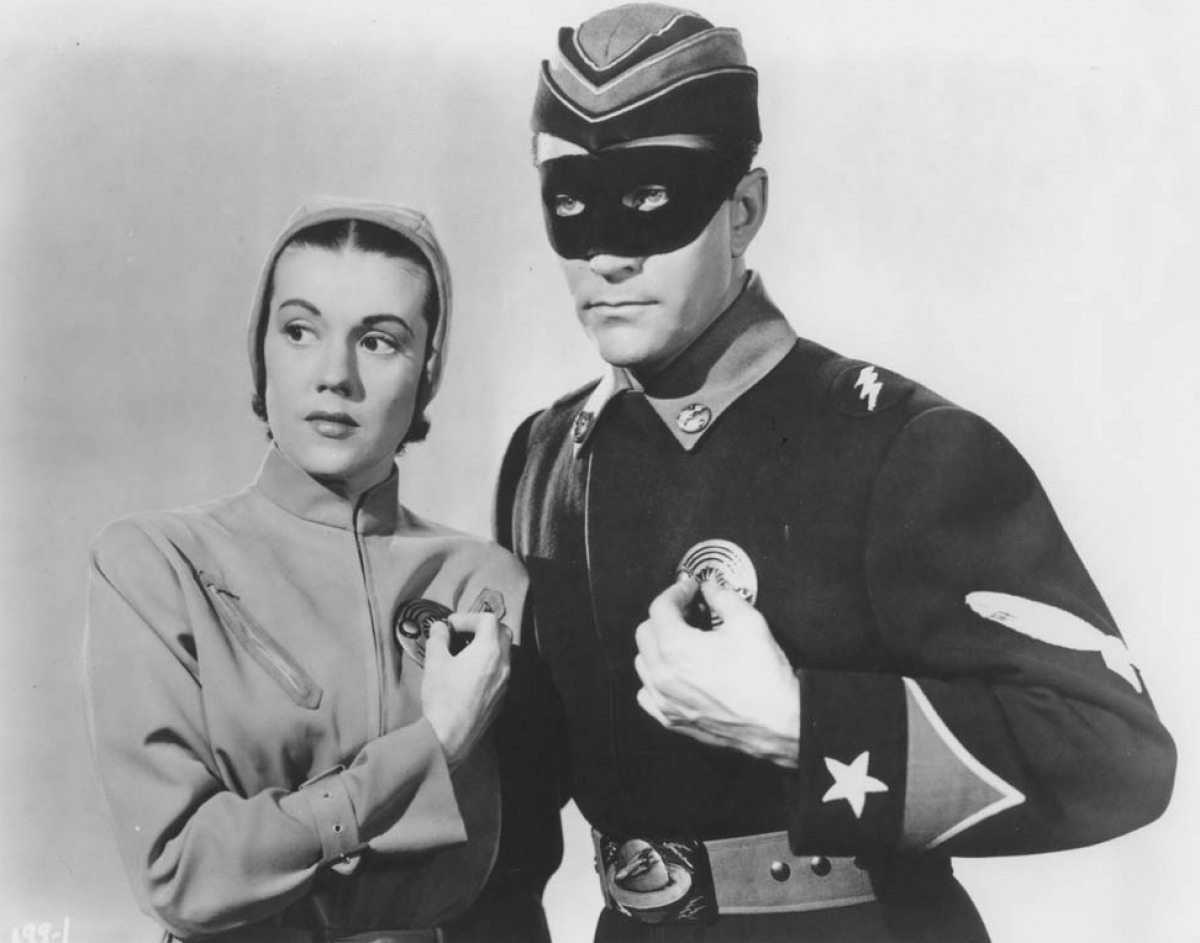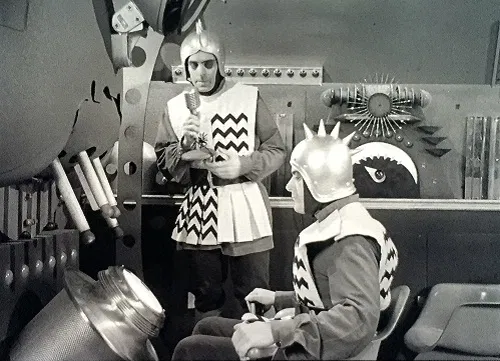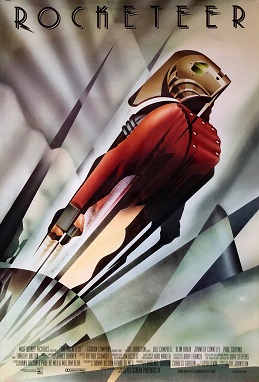|
|
Commando Cody: Sky Marshall of the Airwaves
by Lee Weinstein
A man wearing a jet-pack and a bullet-shaped helmet emerges from a building, twists the dials on the front of his jacket, takes a running start, and blasts off into the sky in a perfect cinematic illusion of flight. The title of the show, Commando Cody, Sky Marshall of the Universe appears, superimposed across the sky.

I first saw Commando Cody in 1955 on Saturday morning television and eagerly followed it from week to week. I still remember my disappointment when I tuned in one Saturday morning at the same time and channel, but was greeted instead with the first episode of Fury, a show about a young boy on a ranch and his pet horse.
Commando Cody had come to a conclusion after a mere twelve episodes. As I discovered decades later, there was a good reason for this, but it had nothing to do with popularity or ratings. It was due to the unique history of the show, an experiment which grew directly out of movie serials. Specifically, it was intended to be a made-for-television prequel to the Republic serial, Radar Men from the Moon (1952). Movie studios were losing ground to a growing threat called “television” and Republic Studios wanted to cross over into this new market.
Modeled on twelve-chapter Republic serials, and with the same actors and production crew, it is often mistaken for a serial, but it was nonetheless a television series and varied in some significant ways from its serial roots. While serial chapters at that time ran for about 15 minutes, the Commando Cody episodes run for about half an hour, allowing for more dialog and plot development. While a serial would typically have the same directors and writers throughout, the TV show’s writers and directors varied from episode to episode. And instead of having cliffhanger endings, the episodes are self-contained, often ending in light-hearted humorous moments. However, as in the serials, it had an overall story arc with a beginning, middle and end. It was likely the first television series ever to have one.
As a television series, despite a low budget, Republic’s slick production values gave it a more polished appearance than such contemporary Saturday morning space operas as Rocky Jones, Space Ranger and Tom Corbett, Space Cadet. This was due in part to the smooth incorporation of footage from previous serials and stock footage of natural disasters. The flying sequences, were done by the special effects team of Howard and Theodore Lydecker, originally for King of the Rocketmen (1949). A realistic, life-sized mannequin sliding along an invisible wire was filmed against the California sky with an under-cranked camera and played back at normal speed. Those shots were far more effective than merely having an actor in a harness matted against a back-projected landscape. A similar technique was used for the shots of the spaceships in flight.
Although it was made for television, union contracts obliged Republic to release the episodes in movie theaters first, which they did on a weekly basis in 1953, adding to the confusion about its nature.
The first three episodes follow the plot line of chapter one of Radar Men, but developed more slowly. At the beginning of the serial, Cody (played by actor George Wallace) responds to attacks on earth by taking off for the moon with his assistants Ted Richards (Bakewell) and Joan Gilbert (Aline Towne), where he finds and confronts the lunar tyrant, Retik (Roy Barcroft), and manages to escape, all in chapter one.
The television series, in contrast, has a similar plotline, but Cody (now played by Judd Holdren) doesn’t meet the alien tyrant bent on conquering the universe, "The Ruler" (Gregory Gaye), until the third episode. While subsequent episodes of Radar Men mainly focus, in true serial fashion, on fistfights and car chases as Cody fights Retik’s minions for control of lunar super-rayguns, subsequent episodes of Commando Cody deal with a new global disaster engineered by the Ruler every week.
In the first television episode, “Enemies of the Universe,” scientists Ted (now played by William Schallert) and Joan (again Aline Towne) arrive at Cody’s headquarters and meet him for the first time. They learn he is a brilliant scientist who is so important to earth’s security that he must keep his identity secret by wearing a black mask. He tells them that in response to enemy rockets that had recently landed on earth, he has devised a “cosmic dust blanket” which causes anything approaching earth to burn up in the atmosphere. He then has them assist him in constructing a rocket ship capable of reaching other planets.
Holdren opined in interviews that the mask was to enable the studio to replace him with another actor if need be. He also wears a military-like uniform, as opposed to the business suit worn by George Wallace in the serial.
In the second episode, an alien agent gets through the dust blanket and with a henchman on earth attempts to steal Cody’s newly-built rocket ship. It is only in episode three that Cody discovers someone called “The Ruler” is behind the schemes and is on Venus. They travel there in his rocket ship, which he has equipped with a “dispersal ray” to penetrate the dust blanket, and he confronts the Ruler in a cavern on Venus. They escape after melting the entrance to the cavern and destroying the Ruler’s headquarters.
Things seem to have come to a logical conclusion, with the enemy apparently destroyed, but in episode four, “Nightmare Typhoon,” the Ruler, like Ming the Merciless, has inexplicably survived to attack earth again. Starting with this episode there are several noticeable changes in the casting. Cody’s assistant Ted has been transferred elsewhere and a new assistant, Dick Preston (Richard Crane), replaces him. He injects some comic relief into the show. (In 1954, Crane went on to play the lead in Rocky Jones, Space Ranger.) Lyle Talbot as Baylor is now the main enemy operative on earth and the Ruler has also gained a young, blonde assistant in his headquarters, played by former model and showgirl, Gloria Pall. His alien henchmen now sport new costumes with spiked helmets and zig-zag designs.

These changes were due to a long gap in the production schedule. After the first three episodes, filming was put on hiatus while Republic produced a movie serial sequel to Radar Men titled Zombies of the Stratosphere (1952). Filming of the TV series didn’t resume until Zombies was completed.
Confusingly, Zombies also stars Judd Holdren, but unmasked. His character, is named Larry Martin instead of Commando Cody. He wears a business suit instead of the military-like uniform in the television show. But despite the name and clothing he is the same character. Supposedly, this was to prevent confusion with the TV series.
As the series resumed, the Ruler attacks the earth with increasingly destructive, and progressively more scientifically improbable plans but with impressive-sounding episode titles.
In “Nightmare Typhoon” his agents seed earth’s clouds causing torrential rains and flooding. In “War of the Space Giants,” he attacks with germ warfare. In “Destroyers of the Sun” he tries to put the sun out with a ray beamed from an extra-solar planet. In “Hydrogen Hurricane” he blows the moon out of its orbit with an atomic explosion causing massive worldwide hurricanes. In “Solar Sky Raiders” he multiplies the sun’s heat by a factor of five, threatening to scorch the world. In “S.O.S. Ice Age” the Ruler’s men plant a device near the North Pole to link the earth’s rotation to Saturn’s, causing earth’s axis to tilt.
The final two episodes wrap up the series as Cody and his team lure the Ruler to the planet Mercury and with the help of the Mercurians, finally bring him to justice at the end. Although it is commonplace today, this is probably the earliest TV series with a definite conclusion, predating The Fugitive by a decade.
After its initial run on NBC in 1955, the series was occasionally repeated in syndication. This is highly unusual for a series of only 12 episodes, but perhaps not so unusual for a miniseries, although the term and even the concept didn’t exist yet.
It is also arguably the first science fiction series to be shot on film, rather than air live. Rocky Jones: Space Ranger, which first ran in 1954, is often credited with this, but Commando Cody, although it didn’t air on television until the following year, was filmed and released to theaters in 1952-1953.
Following Commando Cody, Republic produced a few other television series, little known today, including Stories of the Century (1953), Dr. Fu Manchu (1956) and Frontier Doctor (1958) but these failed to save the studio. Republic ceased serial production in 1955 and feature film production in 1958-9. These other series lacked story arcs and ran for full seasons of 39 episodes, with the exception of Dr. Fu Manchu, which was canceled after 13 episodes.
Although it had such a short run, the show did leave its mark on popular culture. His name was reflected in the name of the late 1960’s rock band Commander Cody and his Lost Planet Airmen.
His iconic flying suit, originally used in King of the Rocketmen was an obvious inspiration for the graphic novel and later the film The Rocketeer (1991).

The miniseries format was reinvented years later and employed in such imaginative series as The Prisoner (1967), The Martian Chronicles (1980), and Dune (2000). Australia in the 1990’s produced a number of half-hour science fiction miniseries including The Girl from Tomorrow (1991-92), Escape from Jupiter (1994-95), and Spellbinder (1995), complete with cliffhanger endings.
While Republic’s experimental entry into television ultimately failed, Commando Cody was a pioneering effort well ahead of its time, and should be credited as television’s very first miniseries. It is still available today on DVD and Blu-Ray.
Click to purchase from Amazon
 |
ABOUT THE AUTHOR
Lee Weinstein is a retired librarian and a life-long science fiction fan who also dabbles in oil painting. His essays have appeared in Studies in Weird Fiction, The New York Review of Science Fiction and elsewhere. He is a contributor to The Encyclopedia of Science Fiction, (the online 3rd edition), Horror Literature through History and has edited several short story collections. He and his wife reside in Philadelphia, PA with their black cat, Annabel. |
 |
Click on the icons for new features in The Thunder Child.
Radiation Theater: 1950s Sci Fi Movies Discussion Boards
The Sand Rock Sentinel: Ripped From the Headlines of 1950s Sci Fi Films
|
 |
|
|



